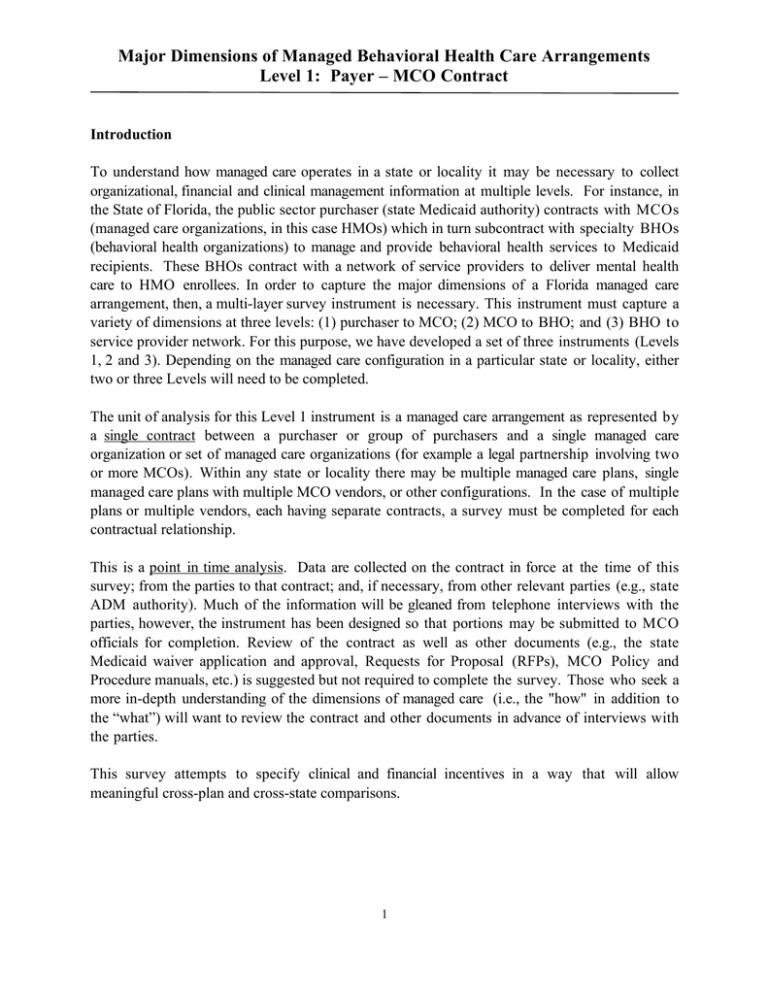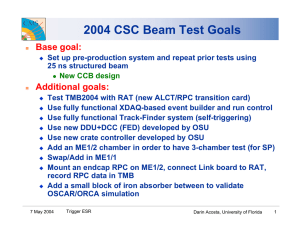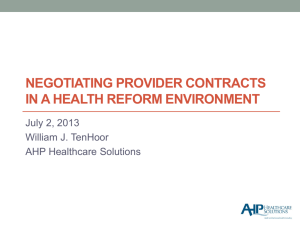Major Dimensions of Managed Behavioral Health Care Arrangements
advertisement

Major Dimensions of Managed Behavioral Health Care Arrangements Level 1: Payer – MCO Contract Introduction To understand how managed care operates in a state or locality it may be necessary to collect organizational, financial and clinical management information at multiple levels. For instance, in the State of Florida, the public sector purchaser (state Medicaid authority) contracts with MCOs (managed care organizations, in this case HMOs) which in turn subcontract with specialty BHOs (behavioral health organizations) to manage and provide behavioral health services to Medicaid recipients. These BHOs contract with a network of service providers to deliver mental health care to HMO enrollees. In order to capture the major dimensions of a Florida managed care arrangement, then, a multi-layer survey instrument is necessary. This instrument must capture a variety of dimensions at three levels: (1) purchaser to MCO; (2) MCO to BHO; and (3) BHO to service provider network. For this purpose, we have developed a set of three instruments (Levels 1, 2 and 3). Depending on the managed care configuration in a particular state or locality, either two or three Levels will need to be completed. The unit of analysis for this Level 1 instrument is a managed care arrangement as represented by a single contract between a purchaser or group of purchasers and a single managed care organization or set of managed care organizations (for example a legal partnership involving two or more MCOs). Within any state or locality there may be multiple managed care plans, single managed care plans with multiple MCO vendors, or other configurations. In the case of multiple plans or multiple vendors, each having separate contracts, a survey must be completed for each contractual relationship. This is a point in time analysis. Data are collected on the contract in force at the time of this survey; from the parties to that contract; and, if necessary, from other relevant parties (e.g., state ADM authority). Much of the information will be gleaned from telephone interviews with the parties, however, the instrument has been designed so that portions may be submitted to MCO officials for completion. Review of the contract as well as other documents (e.g., the state Medicaid waiver application and approval, Requests for Proposal (RFPs), MCO Policy and Procedure manuals, etc.) is suggested but not required to complete the survey. Those who seek a more in-depth understanding of the dimensions of managed care (i.e., the "how" in addition to the “what”) will want to review the contract and other documents in advance of interviews with the parties. This survey attempts to specify clinical and financial incentives in a way that will allow meaningful cross-plan and cross-state comparisons. 1 Major Dimensions of Managed Behavioral Health Care Arrangements Level 1: Payer – MCO Contract GENERAL DESCRIPTION OF THE MANAGED CARE ARRANGEMENT (1-2) Parties to the Contract Rationale To identify the entities which are parties to this contract (i.e., contractually obligated under this arrangement) and the relative contributions of purchaser funds that will be distributed through this contract. Definitions (1) • Purchasers - parties to the contract who have committed funds to pay for services provided under the contract. (2) • Vendors - parties to the contract who are assuming contractual responsibility for management and/or provision of administrative and/or clinical services under the contract. In some cases, multiple vendors may be signatories to a single contract. Potential Sources -MCO Contract (i.e., contract between purchaser and vendor) -State Medicaid authority, State Alcohol, Drug and Mental Health authority, other Purchaser 2 Major Dimensions of Managed Behavioral Health Care Arrangements Level 1: Payer – MCO Contract (3-4) Type of Medicaid Waiver Rationale The type of Medicaid waiver (e.g., Section 1115, Section 1902) defines some of the parameters of managed care arrangements. Definitions Prior to the Balanced Budget Act [BBA] of 1997, there were two waivers States used to develop Medicaid managed care programs: • Section 1915(b) - Freedom of choice (FOC) waivers are authorized under section 1915(b) of the Social Security Act. Through this section, HCFA may give States the authority to waive certain provisions of section 1902 of the Act including: a) beneficiaries’ right to select their own Medicaid providers, b) comparability of services, and c) the requirement to make any service provided available statewide. 1915(b) waivers allow States to place beneficiaries in primary care case management programs (PCCMs), or in a prepaid capitated arrangement which can involve mandatory enrollment in health maintenance organizations (HMOs), health insuring organizations (HIOs), or prepaid health plans (PHPs). 1915(b) waivers are approved for 2-year periods and may be renewed at 2-year intervals. FOC waiver programs must ensure that Medicaid beneficiaries have a choice of at least two or more providers. The Balanced Budget Act amended the Social Security Act so that 1915(b) waivers are not longer required (with the exception of programs that involve special needs children). Changes are simply included in the state’s Medicaid plan. However, states with waivers in place at the time of the passage of BBA continue to comply with waiver requirements until their waivers expire. • Section 1115 - Section 1115 waivers are also called “research and demonstration” waivers. Under Section 1115 of the Act, States can deviate from a great many standard Medicaid requirements in order to test new ideas of policy merit. In return for greater flexibility, such States must commit to a policy experiment that can be formally evaluated. Demonstration waiver authority can normally be granted for up to 5 years at a time. Under 1115 demonstrations, for example, States may: (a) require beneficiaries to stay enrolled in the same managed care plan for longer periods of time, (b) cover new services, (c) offer different service packages in different parts of the State (d) test new reimbursement methods, and (e) change Medicaid eligibility criteria in order to offer coverage to new or expanded groups. In addition, 1115 demonstrations must demonstrate that they are budget neutral. This means that such programs cannot cost more over their duration than the Medicaid program would have spent in the absence of the demonstration. Note: The Balanced Budget Act (BBA) did not fundamentally alter the Section 1115 waiver. 3 Major Dimensions of Managed Behavioral Health Care Arrangements Level 1: Payer – MCO Contract States can also establish voluntary managed care programs: • Sections 1902(a) & 1903(m) - Under these sections of the Social Security Act, states can give Medicaid beneficiaries the option of enrolling in Medicaid managed care plans. Under a voluntary program, recipients can disenroll from their Medicaid managed care plan or simply decline altogether to sign up with plans. If a state contracts with plans under the auspices of these two sections, then it no longer needs to satisfy certain federal requirements of the Medicaid program: 1) freedom of provider choice, 2) comparability of benefit package for all, and 3) statewideness. These two sections also allow states to contract with a variety of managed care plans, including HMOs, HIOs, and PHPs. However, States are not authorized to establish voluntary primary care case management programs under these two sections. Potential Source -State Medicaid authority (waiver requests, HCFA approvals, state Medicaid plans) (5) Geographic Area(s) Covered Rationale To identify the specific geographic area(s) covered in the contract, whether it is rural or urban, whether it overlaps with other contractors in that area, and to give context to enrollment data (i.e., how many members over what geographic area). Definition • Geographic area - the area covered by this contract (may be different from the area covered by the State’s waiver). The geographic area covered by a contract may be an entire state or various sub-state divisions such as regions, counties, or catchment areas Potential Sources -Contract -Managed Care Organization (MCO) 4 Major Dimensions of Managed Behavioral Health Care Arrangements Level 1: Payer – MCO Contract (6-8) Duration of the Contract Rationale Duration provides a sense of the stability and maturity of the managed care arrangement. Definition • Duration - the length of the contract. Contracts ordinarily have a one to two year duration and then must be re-bid; however, some contracts have automatic renewal clauses for either defined or indefinite periods. Potential Sources -MCO Contract THE MANAGED CARE ORGANIZATION (9-10) Organizational Structure Rationale To understand the profit status of the MCO and to gauge the financial and operational support the MCO may have access to as part of a larger corporate entity. Potential Sources -MCO “corporate capability statement,” public relations material, web-site -State Insurance Commissioner or Department of Insurance reports 5 Major Dimensions of Managed Behavioral Health Care Arrangements Level 1: Payer – MCO Contract (11) Administrative Services Provided by the MCO Rationale To understand the functions of the MCO under this contract. Definitions (11a) • Administrative Services - services other than direct provision of care including, but not limited to the following: • Eligibility Determination - screening individuals for eligibility for enrollment in the plan. • Enrollment - maintaining enrollment records and verifying eligibility for provision of care on an ongoing basis. • Claims Administration - Payment of capitation fees and fee-for-service bills to direct care providers for service provision after verifying legitimacy of claims. • Utilization Review - formal assessment of the medical necessity, efficiency, and/or appropriateness of health care services and treatment plans on a prospective, concurrent, or retrospective basis. (11b) • Provider - A physician, hospital, group practice, nursing home, pharmacy, or any individual or group of individuals which provides a health care service. • Provider Network - a group of physicians, hospitals, laboratories, or other health care providers who participate in a managed care plan’s health delivery program. Providers agree to follow the plan’s procedures, permit the monitoring of their practices, and may provide certain negotiated discounts in exchange for a guaranteed patient pool. • Provider Network Management - contracting with and credentialing of direct care providers. Potential Sources -MCO Contract -MCO Policy and Procedure Manuals (12) Contract as a percentage of MCO business Rationale MCOs may have commercial, Medicaid, Medicare, FEHBP, and CHAMPUS business in the state. The purpose of this inquiry is to understand how much of this MCO’s business is derived from this particular contract as opposed to other payers. Potential Sources -MCO Chief Financial Officer -State Insurance Commissioner or Department of Insurance 6 Major Dimensions of Managed Behavioral Health Care Arrangements Level 1: Payer – MCO Contract ENROLLED POPULATIONS (13-14) Covered Lives Rationale To identify the base rate of enrollees in order to allow meaningful comparisons across plans. Definitions (13) • Family Unit Basis – Counting scheme under which each family is counted as one covered life. • Individual Basis – Counting scheme under which each eligible individual or his dependent is counted as one covered life. (14) • Covered Lives – The number of persons who are enrolled in a health plan or enrolled for coverage by a provider network; may be determined on a family unit or individual basis. Potential Sources -State Medicaid authority (e.g., monthly enrollment reports) -MCO Note: It is possible to get this information from each MCO when there are multiple plans, however, care must be taken to get a systematic counting across plans. Generally, a single source for the information is preferable. (15-16) Beneficiary Eligibility Categories Rationale To understand the eligibility categories, disability categories, and age groups covered under this contract. This provides one way to look at case mix, although disability status is an imperfect measure of severity. Definitions (15) • Medicaid/Elderly - dually eligible; receiving both Medicaid and Medicare. • Medicaid/Disabled - receiving Supplemental Security Income (SSI) for income maintenance and Medicaid for health benefits • Medicaid/Other – other Medicaid beneficiaries (e.g., Aid to Families with Dependent Children (AFDC) / Temporary Assistance to Needy Families (TANF) recipients) 7 Major Dimensions of Managed Behavioral Health Care Arrangements Level 1: Payer – MCO Contract (16) • Child/Adolescent With Severe Emotional Disturbance – a person under the age of 18 who has a diagnosable mental, behavioral, or emotional disorder (for example: conduct disorder, childhood depression, or attention deficit/hyperactivity disorder) of sufficient duration to meet diagnostic criteria specified within DSM IV, and that results in functional impairment which substantially interferes with or limits the child’s role or functioning in family, school, or community activities. • Adult With Severe Mental Illness – a person 18+ years who has a major mental disorder (for example: schizophrenia, bipolar disorder, or major depression) that is severe, persistent and disabling. By disabling it is meant that a person’s capacity to function in primary aspects of life (such as self-care, interpersonal relationships, work or schooling) has been severely impaired for at least one year. • Developmental Disability a severe, chronic disability of a person which (a) is attributable to a mental or physical impairment or combination of impairment; (b) is manifested before the person attains age twenty-two; (c) is likely to continue indefinitely; and (d) results in substantial functional limitations in major life activities such as self-care, language, leaning, mobility, self-direction, capacity for independent living and economic selfsufficiency. • Substance Abuse Disorder – a maladaptive pattern of substance use manifested by recurrent and significant adverse consequences related to the repeated use of substances such as alcohol, amphetamines, cocaine, hallucinogens, inhalants, opiates, etc. The use of substances must be of sufficient duration to meet DSM IV diagnostic criteria for substance abuse or substance dependence. Potential Sources -MCO Contract -State Medicaid authority (e.g., Waiver request/approval) BENEFIT DESIGN AND "MEDICAL NECESSITY" (17) Covered Services Rationale It is important to understand both the benefit design and the “rules” for accessing services. The benefit plan specifies a list of services and substitutions for those services, provides a template for the risk sharing arrangements, and drives the specification of the provider network. The rules for accessing services are dictated by the “medical necessity” criteria in the contract as implemented by the MCO in their utilization management This section includes information on all covered services; specifying amount, scope and duration limits as well as the financing mechanisms (e.g., capitation, fee-for-service reimbursement, etc.) 8 Major Dimensions of Managed Behavioral Health Care Arrangements Level 1: Payer – MCO Contract Definitions • Covered Services - Those services that the purchaser requires the MCO to provide or arrange for the provision of under the terms of the contract. Some services may be covered only if they are incidental to other covered services - for example, a mental health “carve out” plan may require the MCO to provide substance abuse treatment for the plan’s members who have substance abuse disorders co-occurring with their mental disorders (i.e., “dual diagnosis”). There also may be health plans that require the MCO to provide substance abuse treatment only to substance-abusing pregnant women during the course of pre-natal care. In these cases, substance abuse services should be coded as available for some and specified. Potential Source -MCO Contract -State Medicaid authority (waiver request/approval) (18-20) Benefit Plan Definitions (18) Mental Health Services • (a) Screening And Diagnosis Of A Mental Disorder – Assessment, evaluation, and testing provided for the purpose of diagnosing or developing a treatment plan for a disorder by a qualified mental health professional. • (b) Inpatient Hospital Care (Long Term) – treatment in a hospital that specializes in the treatment of persons with mental illness with lengths of stay that typically exceed 45 days (e.g., state mental hospital). i. State Hospital ii. Non-State Hospital - private psychiatric facility • (c) Inpatient Hospital Care For Psychiatric Conditions (Short Term) – treatment in either a specialty hospital or ward of a general hospital that specializes in the treatment of persons with mental illness where lengths of stay typically are less than 45 days. • (d) Assertive Community Treatment - an intensive community treatment model providing highly individualized services to consumers. ACT teams are typically multidisciplinary and provide a variety of treatment, rehabilitative and support services. • (e) Clinical Case Management For People With Psychiatric Conditions – Coordination of mental health or social services in the community by an individual whose role is to ensure continuity and accessibility of services, make appropriate referrals, and to assist the client in matching the intensity of services to his or her needs over time. (does not include utilization review case management) 9 Major Dimensions of Managed Behavioral Health Care Arrangements Level 1: Payer – MCO Contract • • • • • • • • • • (f) Partial/Day/Night Treatment For Psychiatric Conditions – Partial hospitalization (an active outpatient psychiatric day or evening treatment) or other types of partial care provided to persons with mental illness; the purpose of these services may be to avert inpatient hospitalization. Treatment is usually provided for more than 1, but less than 24 hours/day. (g) Outpatient Care For Psychiatric Conditions – Visits to a mental health professional or clinic for the purpose of therapy or treatment of a mental illness; does not include any type of inpatient or residential care; may include individual, group, or family therapy by a mental health professional. (h) Emergency Care/Crisis Services – Short-term mental health services in a facility such as an emergency room for persons who are in a crisis or emergency situation. The length of stay in the facility usually does not exceed 24 hours. (i) Psychotropic Prescription Drugs – pharmacological agents intended to treat the symptoms of mental illness (j) Medication Management – typically a brief contact between a person diagnosed with a mental illness and a physician or nurse practitioner to assess the success of drug therapies. Sessions may involve adjusting drug dosages, changing drug prescription, etc. (k) Supervised Residential Treatment For Psychiatric Conditions – 24 hour care in a community program designed to provide treatment for mental illnesses. (l) Supported Living Services – support services provided by mental health professionals, sometimes in conjunction with consumer/survivors, that include: social rehabilitative services; community living skills training; assistance in the development of social networks; and support, socialization, recreational and other activities; excludes residential treatment programs (m) Vocational Programs – Rehabilitation programs designed to aid individuals in obtaining employment, including assessment, skills training, or placement and/or funding for workshops or supported employment programs. (n) Self-Help/Mutual Support Programs – Programs organized by and for consumers for the purpose of helping members cope with their illness, including clubhouses. (o) In-Home Support Interventions for Children - respite care, in-home therapy, or other supports provided in the home for children or adolescents with severe emotional disturbances. (19) Substance Abuse Services • (a) Screening And Diagnosis Of A Substance-Related Disorder - evaluation by a person specially trained or experienced in alcohol and other drug abuse treatment to diagnosis and develop a treatment plan for alcohol or drug abuse disorders. • (b) Inpatient Hospital Care For Substance-Related Disorders– treatment in a hospital that specializes in the treatment of alcohol or drug abuse disorders • (c) Inpatient Detoxification- twenty-four hour medically-managed acute services for detoxification for persons with severe or medical complications associated with withdrawal. 10 Major Dimensions of Managed Behavioral Health Care Arrangements Level 1: Payer – MCO Contract • (d) Residential Detoxification - twenty-four hour medically managed services that provide for safe withdrawal and transition to ongoing treatment. • (e) Outpatient Detoxification - outpatient treatment services provided for less than 24 hours per day that provide for withdrawal in an ambulatory setting. (f) Intensive Outpatient Treatment For Substance Related Disorders – Outpatient services provided to a client that last two or more hours per day for three or more days per week. (g) Standard Outpatient Treatment for Substance Related Disorders - Visits to a mental health professional or clinic for the purpose of therapy or treatment of a substance abuse disorder (does not include any type of inpatient or residential care); may include individual, group, or family therapy by a substance abuse professional. (h) Clinical Case Management For People With Substance Abuse Disorders – Coordination of mental health, substance abuse, or social services in the community by a designated case manager (usually a social worker), whose role is to ensure continuity and accessibility of services, make appropriate referrals, and to assist the client in matching the intensity of services to his or her needs over time. (i) Methadone Therapy – Use of methadone for persons addicted to opiates during the withdrawal and maintenance phases of treatment. (j) Residential Substance Abuse Treatment – 24 hour care in a community program designed to provide treatment for substance abuse disorders. (k) Halfway house – a residential program for persons recovering from a substance abuse disorder. Staff may provide some services, some halfway houses, however, are organized and run by the recovering individuals living there. Treatment and/or drug screening may be provided on site. • • • • • • (20) Health services • (a) Screening And Diagnosis Of A Medical Condition – evaluation by a medical professional to diagnose and develop a treatment plan for a medical condition. • (b) Inpatient Hospital Care – hospital treatment involving at least an overnight stay for the treatment of medical conditions. • (c) Primary Care Outpatient Visits – visits to a primary care physician or nurse practitioner (e.g., general practitioner, internist, family medicine specialists, etc.) for the diagnosis and treatment of a medical condition. • (d) Specialty Care Outpatient Visits – services delivered by a physician who is specially trained in a specific area of medicine (e.g., orthopedics for bones; cardiologist for heart problems, etc.) • (e) Emergency Care – services provided by a medical facility which is open 24 hours a day, such as an emergency room or urgent care clinic. Individuals will remain in these settings less than 24 hours. • (f) Non-Psychotropic Prescription Drugs – pharmacological agents intended to treat the 11 Major Dimensions of Managed Behavioral Health Care Arrangements Level 1: Payer – MCO Contract • symptoms of medical illnesses. (g) Medication Management – typically a brief contact between a person diagnosed with a disorder and a physician or nurse practitioner to assess the success of drug therapies. Sessions may involve adjusting drug dosages, changing drug prescription, etc. (21) State Hospitals and Court-Ordered Treatment Rationale If MCOs could avoid the cost of inpatient care by using state subsidized mental hospitals (through voluntary admission, civil commitment or criminal commitment) this might represent a significant cross subsidy from the public ADM sector. Therefore it is important to know if state mental hospital stays are included in the benefit plan. This information has implications for interpreting overall costs and the sufficiency of capitation payments to MCOs and/or providers. Definitions • Court-Ordered Treatment - Treatment in state mental hospitals as well as any other facilities designated in the state's civil commitment statute or regulations (e.g., community or general hospitals, crisis stabilization units, etc.); may include evaluations to determine competence to stand trial, inpatient treatment, or community treatment for persons found incompetent to stand trial or not guilty by reason of insanity. • Civil Commitment - involuntary psychiatric hospitalization of a person who is not charged with criminal conduct. • Criminal Commitment - involuntary psychiatric hospitalization of a person who is charged with violation of one or more criminal statutes. Potential Sources -Contract -State Alcohol, Drug and Mental Health Authority 12 Major Dimensions of Managed Behavioral Health Care Arrangements Level 1: Payer – MCO Contract (22-24) Services Paid for by State ADM, SA or MH Authorities Rationale In order to reasonably compare managed care plans it is necessary to determine whether there are services available to enrollees that are not paid for under the managed care contract. For instance, if the state ADM authority provides general revenue funding for crisis stabilization units and those beds are available to plan members, this additional resource would undoubtedly affect the plan’s patterns of service utilization and overall costs for mental health services. All potential cross subsidies should be identified. Potential Sources -State ADM authority -State Medicaid authority -“Safety net” providers (25-29) Medical Necessity and Benefit Coverage and Determination Procedures Rationale The benefit plan is not a good guide to understanding what services are available to enrollees. Medical necessity criteria are used by the plan to determine which services will be authorized. This section documents the definition of “medical necessity” for behavioral health services, and includes information on how the MCO makes these determinations (including specific mechanisms). Definitions (25) • Medically Necessary – Services or supplies which meet the following tests: they are appropriate and necessary for the symptoms, diagnosis, or treatment of the medical condition; they are provided for the diagnosis or direct care and treatment of the medical condition; they meet the standards of good medical practice within the medical community in the service area; they are not primarily for the convenience of the plan member or the plan provider; and they are the most appropriate level or supply of service which can safely be provided. This standard is becoming the most important one for providers to focus upon. (26) • ASAM Criteria - American Society of Addiction Medicine criteria for placement and discharge for substance abuse treatment services. • Clinical/Treatment Protocols –Practice guidelines designed to aid clinicians in making decisions about appropriate treatment and level of care for a particular disorder. 13 Major Dimensions of Managed Behavioral Health Care Arrangements Level 1: Payer – MCO Contract (28) • Appeal - A formal request by a covered person or provider for reconsideration of a decision such as a utilization review recommendation, a benefit payment, or an administrative action. (29) • Utilization Review - a formal assessment of the medical necessity, efficiency, and/or appropriateness of services and treatment plans on a prospective, concurrent, or retrospective basis. • Prior Authorization – a review to determine if proposed treatment is medically necessary conducted by an internal or external reviewer before services are provided. Services must be authorized by the responsible entity in order for payment to be made. • Concurrent Review - A routine review by an internal or external utilization reviewer during the course of a patient's treatment, the aim of which is to determine if continued treatment is medically necessary. This mechanism is most frequently used for inpatient, residential, and partial hospitalization treatment, though it is becoming more frequent for outpatient as well. • Retrospective Review - A review that is conducted after services are provided to the patient. The review focuses on determining the appropriateness, necessity, quality, and reasonableness of services provided. Potential Sources -MCO Contract -MCO Policy and Procedures manual 14 Major Dimensions of Managed Behavioral Health Care Arrangements Level 1: Payer – MCO Contract (30-35) Assumption of Risk Rationale Since the risk for loss or benefit is assumed to be an important motivator of organizational and individual behavior, it is important to understand how risk is distributed across systems. In this section information is gathered on the financing arrangement and the amount of risk being transferred from the purchaser to the MCO. Definitions (30) • Capitation - A method of financing services in which a fixed, per-person amount is paid to a health care provider for a contractually agreed-upon set of services over a given time period, usually expressed as per-member-per-month, that is independent of the actual number and type of services provided. • Fee for Service - A method of financing services in which a fee is charged for each service performed, with payment in specific amounts for specific services rendered (as opposed to capitated, salary, or other contract arrangements). • Fee-Per-Inpatient-Episode – Method of provider payment in which a standard fee is set for each inpatient episode rather than for individual services, as with fee-for-service. • Fee-Per-Outpatient-Episode - Method of provider payment in which a standard fee, is set for each outpatient episode, regardless of number of visits actually provided, rather than for individual services, as with fee-for-service. • Case Rate - Method of provider payment in which a standard fee is set for each patient meeting specified criteria. (31-32) • Administrative fee – A separate fee charged by MCO for such administrative services as claims processing, billing, enrollment and overhead. Administrative fees can be expressed as a percentage of premiums or on a per member per month basis. 33-34) (35) • Risk - The chance or possibility of loss by a party to the contract. • Stop Loss Amount – the amount agreed upon by the purchaser and vendor, after which the vendor starts to withdraw money from the risk pool. • Risk Corridor - A mechanism of risk-sharing within a stated range of performance, within which the payer and vendor share the responsibility for the potential rewards and costs of service utilization. • Target Amount - the limit beyond which the purchaser and vendor share the risk through a risk corridor. 15 Major Dimensions of Managed Behavioral Health Care Arrangements Level 1: Payer – MCO Contract • • • Percent Loss Limit - the maximum amount of lost revenue for which the MCO can be held accountable. Percent Profit Limit - the maximum amount of revenue above service costs and administrative costs from which the MCO can profit. Risk Pool - method of risk sharing which involves withholding a certain percentage of the provider's reimbursement payments in a fund into which the payer may also deposit a portion of its premium dollars. In some cases, payments may be made from the fund over the course of the year to cover shortfalls when other sources of payment are insufficient. Any surplus remaining at the end of the year will usually be divided among participating providers; risk pool arrangements are used to create incentives for providers if certain utilization or claims targets are met an penalize providers who do not meet their targets. Potential Source -MCO- Office of Chief Financial Officer -MCO Contract (36-37) Accountability Rationale Having a fixed point of accountability has been suggested as a primary strength of managed care systems. Here we attempt to understand the range of sanctions available to the purchaser in the course of the contract compliance and quality assurance oversight of the vendor. Definitions • Sanction - penalty imposed on vendor by purchaser; may include reduction in payment, suspension of new enrollment, withholding of shared savings, imposition of a corrective action plan, or termination of contract at the extreme end of this continuum. • Non-Performance – Failure to comply with performance standards specified under a contract. Potential Source -State Medicaid authority -MCO Contract THIS IS THE END OF LEVEL 1. 16






